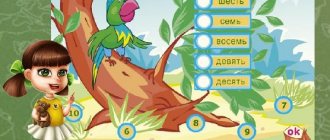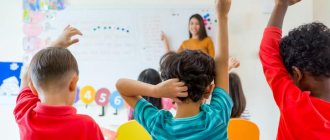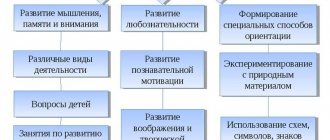Relevance of the problem of speech development
As part of the introduction of the Federal State Educational Standard for preschool education, the requirements for the level of speech development of kindergarten students are being increased as one of the conditions for successful further education at school. The child must be able to use speech as a means of communication, construct a coherent, grammatically correct monologue, and conduct a dialogue.
It is also necessary that he develop phonemic hearing and articulation skills, and form the foundations of intonation culture of speech. The child must have a sufficient vocabulary, be able to perceive texts by ear and retell them.
The problem is that modern children have a deterioration in cognitive and speech development. Therefore, we consider the “Development of coherent speech of children of senior preschool age” to be a relevant topic for self-education.
Self-education plan Topic: “Development of coherent speech in preschool children; (senior group)
Transcript
1 Municipal budgetary educational institution "Khonogorsk basic secondary school named after S.S. Vasiliev" of the municipal district "Ust-Aldansky ulus (district)" of the Republic of Sakha (Yakutia) Agreed by: preschool education methodologist: /Zarovnyaeva G.P./ Minutes Date: Approved : school director: /Shamaeva T.D./ Order Date: Self-education plan Topic: “Development of coherent speech in preschool children; (senior group) for academic year 1
2 Self-education plan for teacher Anna Vasilievna Vasilyeva. Topic: Development of coherent speech in preschool children (senior group) Relevance of the topic: This topic is important to me, because a child’s speech is a key point in his development. The success of pupils in coherent speech ensures in the future and to a greater extent determines success when entering school, contributes to the formation of full-fledged reading skills and improves spelling literacy. As a teacher, this really appeals to me. After all, work on speech development is the ability to choose the right words and use them correctly in speech, construct sentences and coherent speech. As practice has shown, children are very fond of creativity, as well as independence and the opportunity to compose and tell their friends. I try to get the children to show their attitude towards what they saw, what they especially liked, what interested them and why, what conclusions they drew. All this prompted me to pay much more attention to the development of coherent speech in children. Goal: Development of skills of free communication with adults and children; Objectives: - improve the dialogical form of speech; -develop a monologue form of speech; - learn to retell short tales and stories coherently, consistently and expressively; - teach (according to a plan and model) to talk about the subject, the content of the plot picture; make up a story based on pictures; - develop the ability to compose your own stories from personal experience. 2
3 Month Topic Contents of work Practical output September October November December January retellings using supporting diagrams. Retelling the stories “Teremok”, “Grandma Taal-Taal”, Development of speech and personality of a preschooler in fairy tale therapy. Fairy tale therapy: “The Arrogant Bunny”, “Magic Words”, “Naughty Vanya”. Games and exercises for the development of speech in children of senior preschool age. (O.S. Ushakova). Work on compiling stories based on plot paintings. Selection and study of literature on the topic; didactic games and exercises. Teaching a coherent sequential retelling with visual support in the form of graphic diagrams displaying the sequence of events. Teaching children techniques for planning their own retelling. Activation and enrichment of children's vocabulary. Help children imagine their own position in choosing the method of implementing actions, the image of a literary character; encourage the ability to expressively convey emotional states in facial expressions and movements; develop the ability to compose verbal descriptions based on the perception of pantomimic sketches; activate phraseological units in speech. Improve speech hearing, consolidate the skills of clear, correct, expressive speech. Differentiation of sounds, words, sentences. Practice tempo, voice strength, diction. Teach children to look at a picture and highlight its main characteristics; teach children to do research when looking at a picture; form analysis, synthesis; teach children to compose coherent speech. Memos for parents on teaching coherent speech. parents on the topic: “Age-related characteristics of the perception of literary works by preschoolers and the tasks of familiarizing children with the book.” teachers of the preschool educational institution “Fairy Tale Therapy” during classes on speech development.” Introduce parents to games (didactic and lexical and grammatical) that influence the development of children's speech. Parents visiting the activities of teachers and children working on composing stories based on pictures. 3
4 February March April Working with riddles. Making up riddles. development of speech through theatrical activities. Dramatization of fairy tales: “Turnip”, “Kolobok”. intonation, diction, expressiveness of speech while memorizing poems. a story based on a picture based on the teacher’s example. Replenish and activate children's vocabulary. Show the role of riddles in the formation of expressive speech. Teach children to solve riddles using diagrams. Develop children's monologue speech. Development of creative independence, aesthetic taste in conveying an image; development of children's speech and emotional orientation. Unlocking children's creative abilities. Teach children to read poems expressively in front of listeners. Arouse interest in poetry. Replenish and activate children’s vocabulary in speech on the topic “Spring”. parents: “Using riddles as a means of developing expressive speech.” Showing the fairy tale “Kolobok” to children of the younger group. Reading competition. May Learning to write fairy tales. Teach children to compose a fairy tale using a model diagram; tell each other your fairy tales consistently and coherently; learn to come up with a title for a fairy tale; working on a dictionary, learning to select attributes of objects (adjectives to nouns); cultivating interest in fairy tales and their writing. 4
5 List of used literature: 1.. Ushakova O.S. Program for the development of speech of preschool children in kindergarten. M., Ushakova O.S. Development of speech and creativity of preschoolers:. Games, exercises, lesson notes. M.: TC Sfera, K.I. Vasilyeva Oskuola inninee5i saastaah o5olorgo rear oonnuulara Boro5on Gogoleva S.V. Egorova E.I. Teaching coherent Russian speech in Yakut kindergartens Yakutsk Vasilyeva K.I. Kerdeeh ostuoruyalar Djokuuskai: Bichik, Alekseeva M, M, Yashina V.I. “Speech development of preschool children” Moscow L.M. Denyakina, I.I. Stukalova Fairy tales as a means of moral and speech development of preschool children I T.N. Karamanenko, Yu.G. Karamanenko Puppet theater for preschoolers Moscow “Enlightenment” 1982 5
Goals and objectives
The purpose of working on this topic is:
- increasing the theoretical and practical level, competence and professional skills;
- systematization of work on speech development in preschoolers in accordance with the Federal State Educational Standard.
To achieve these goals, it is necessary to solve a number of problems:
- study modern scientific, methodological, reference literature, periodicals on speech development in preschool children;
- develop a long-term plan for the implementation of a problematic topic;
- choose the most effective methods and techniques, didactic games for the development of speech in children;
- determine ways to involve parents in working on speech development;
- conduct diagnostics among children to determine the effectiveness of the applied work system;





